Lignin Hydrolysis and Phosphorylation Mechanism during Phosphoric Acid–Acetone Pretreatment: A DFT Study
Abstract
:1. Introduction
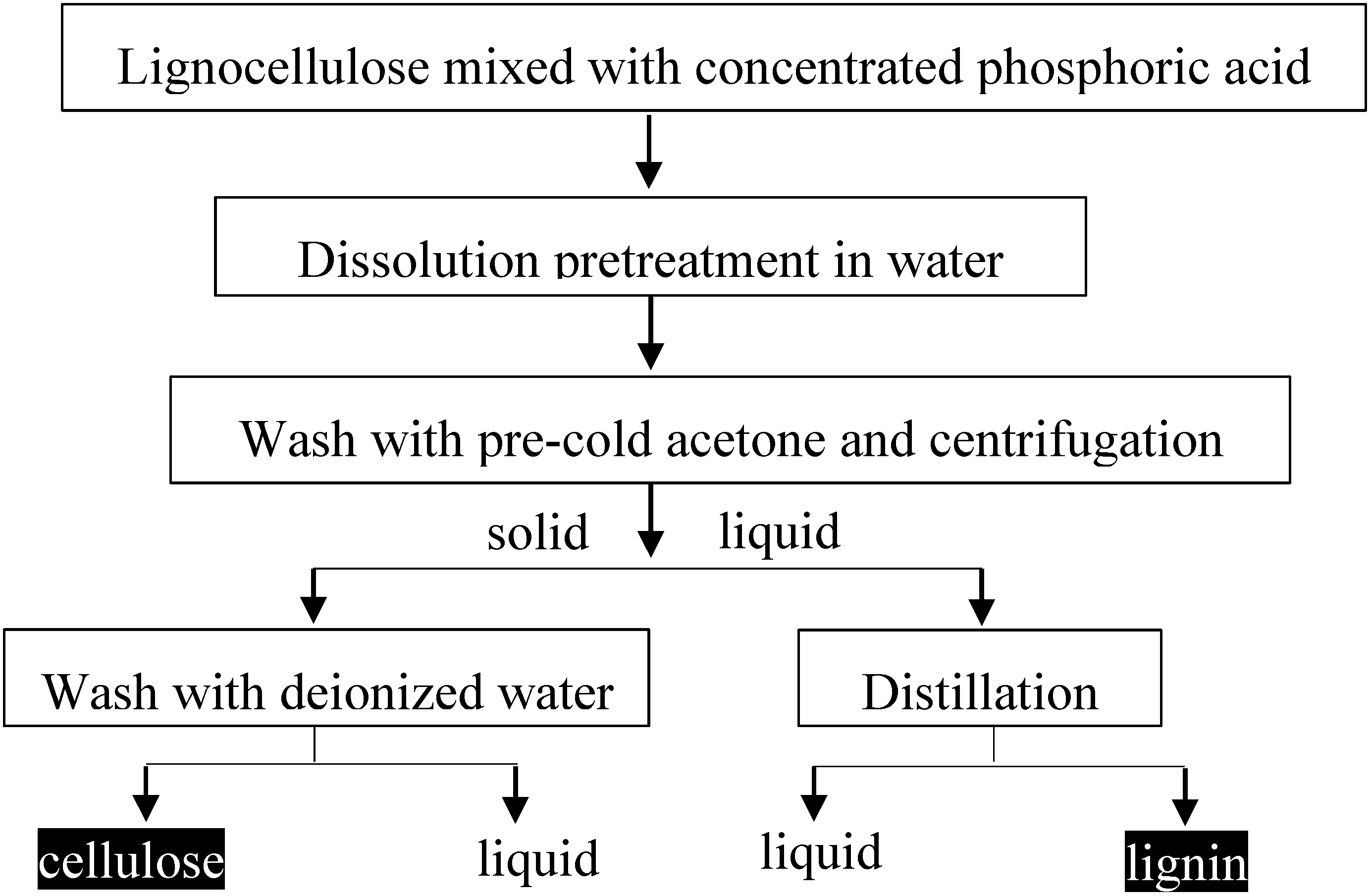
2. Results and Discussion
2.1. Decomposition of Lignin in Various Solutions
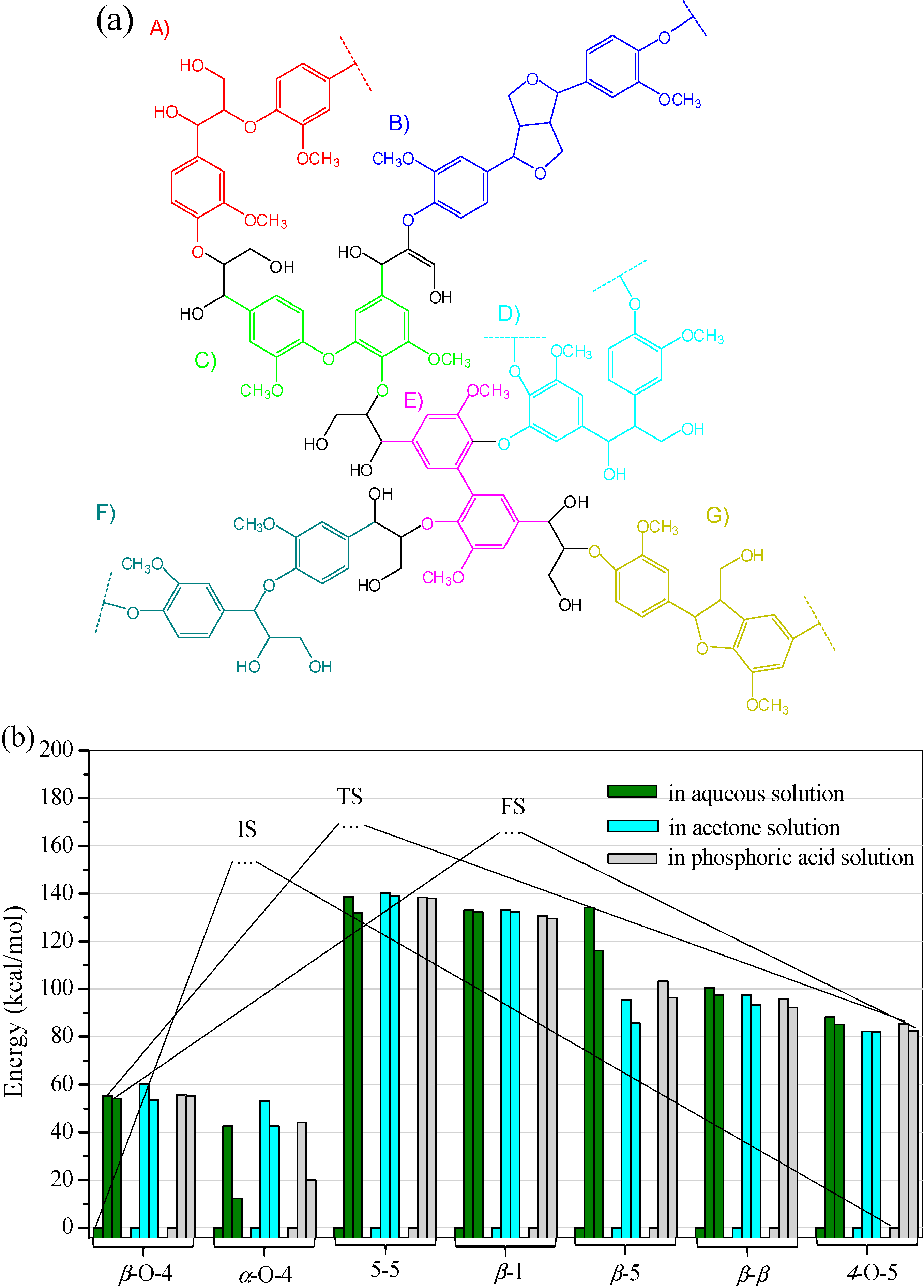
2.2. Phosphorylation of Lignin
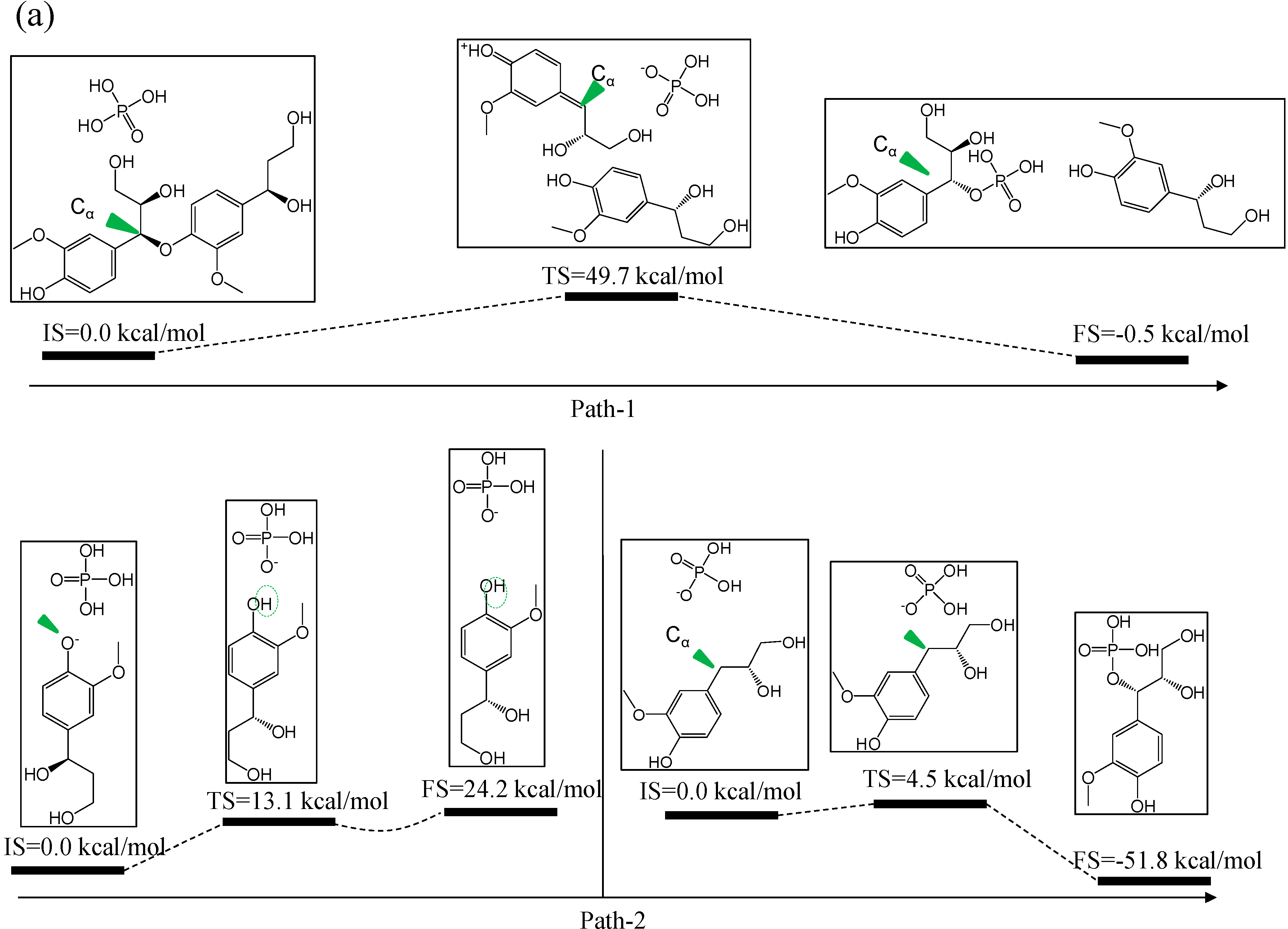
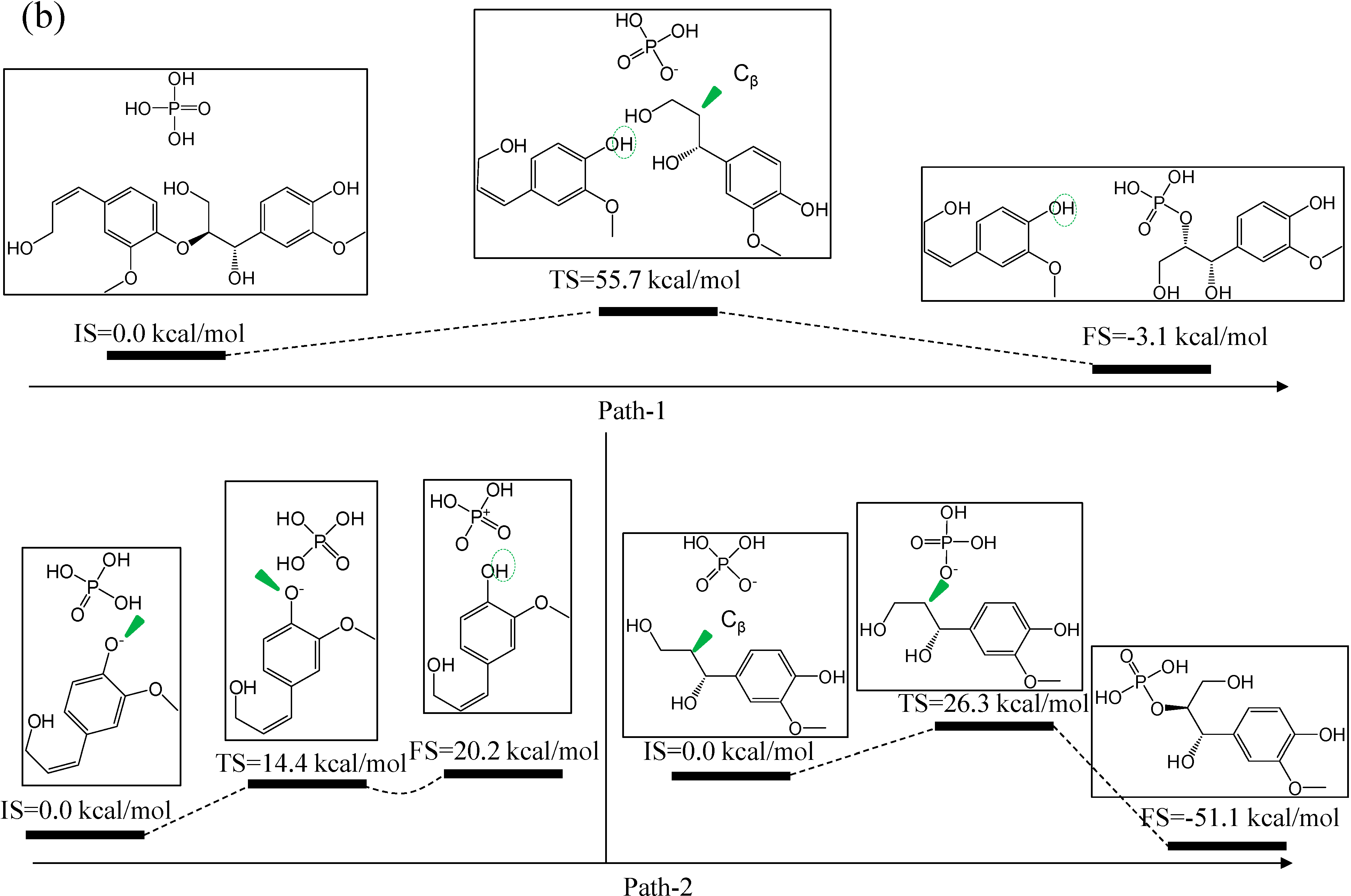
2.3. Hydrolysis of Lignin
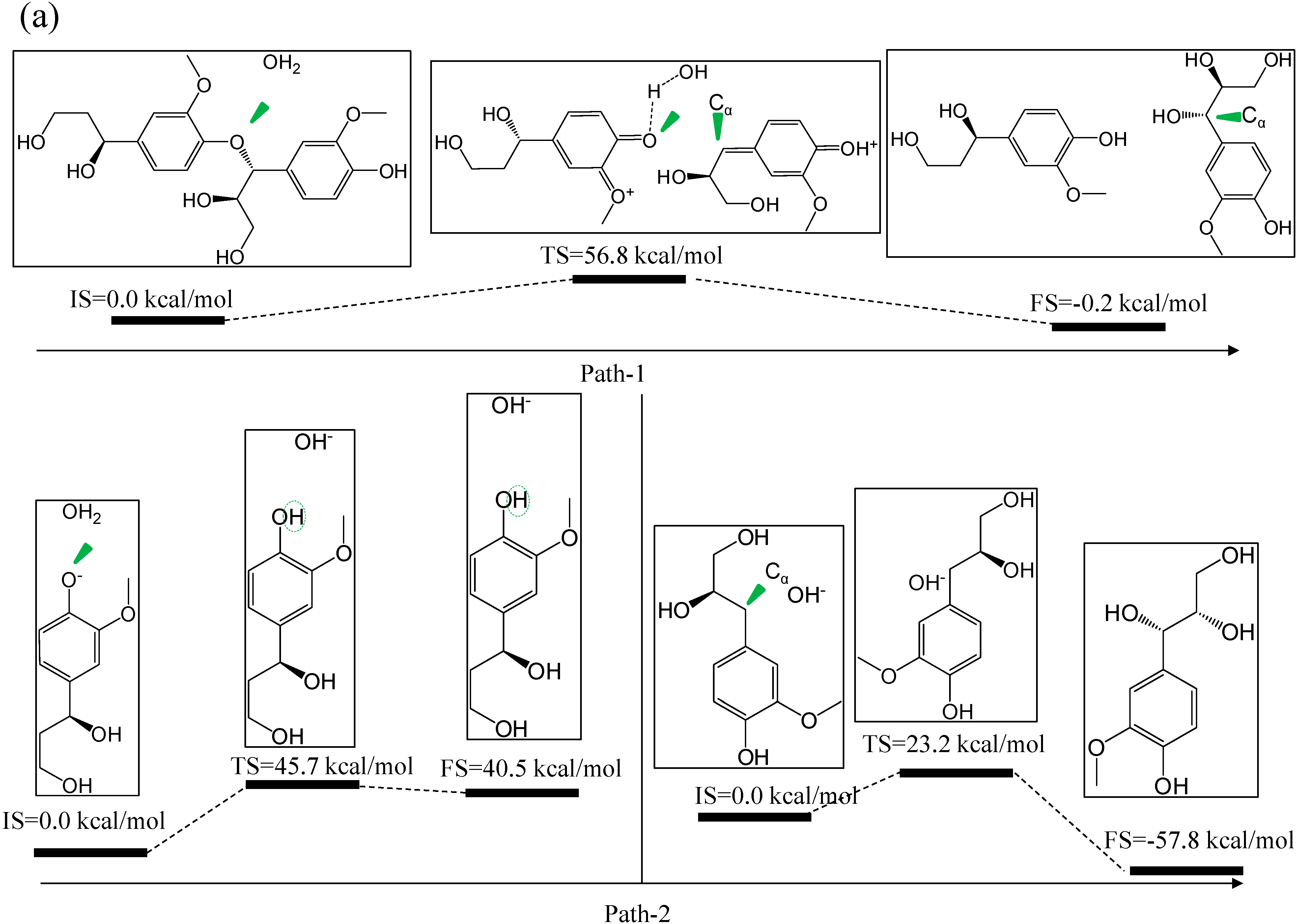
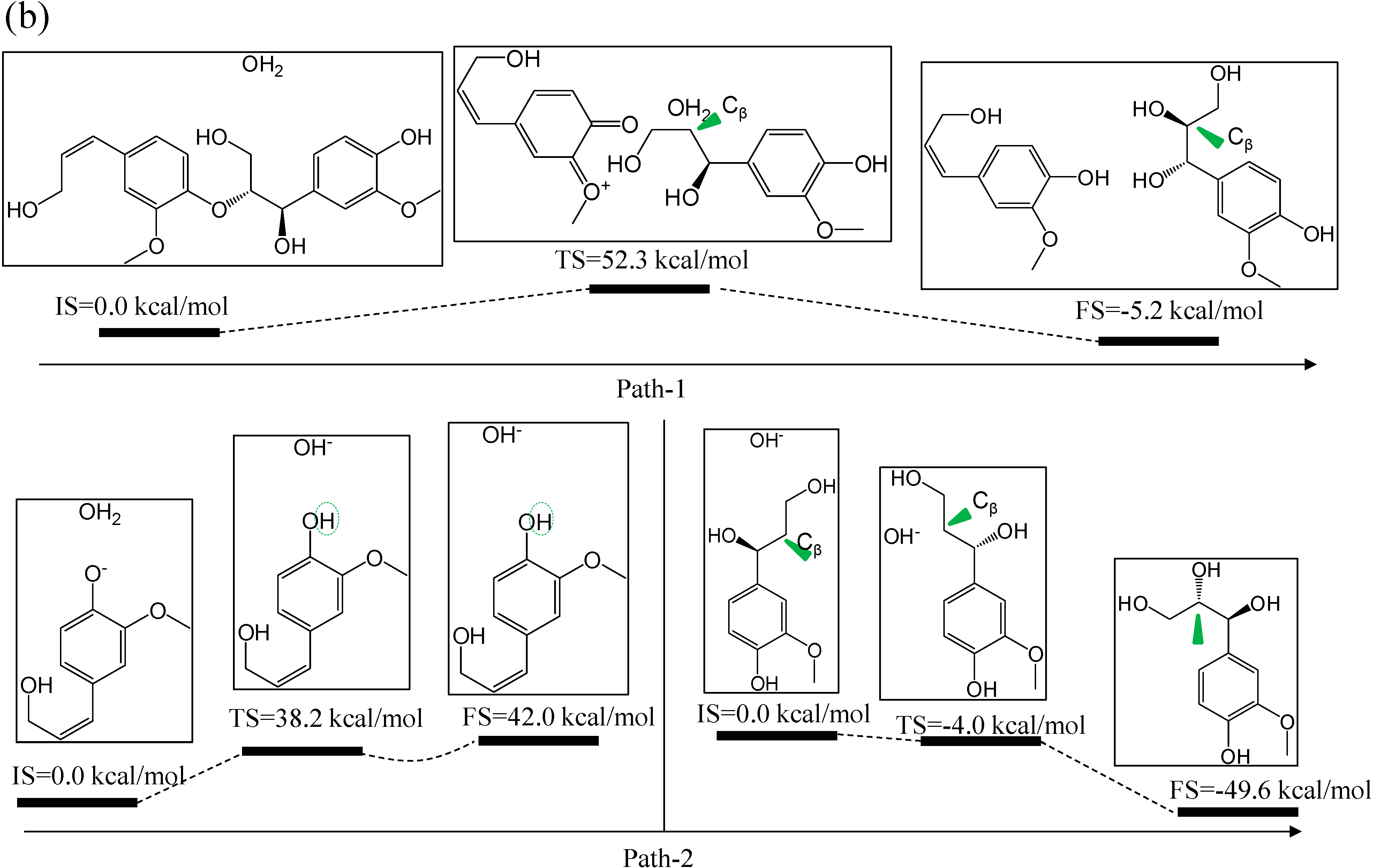
2.4. Properties of the Obtained Lignin
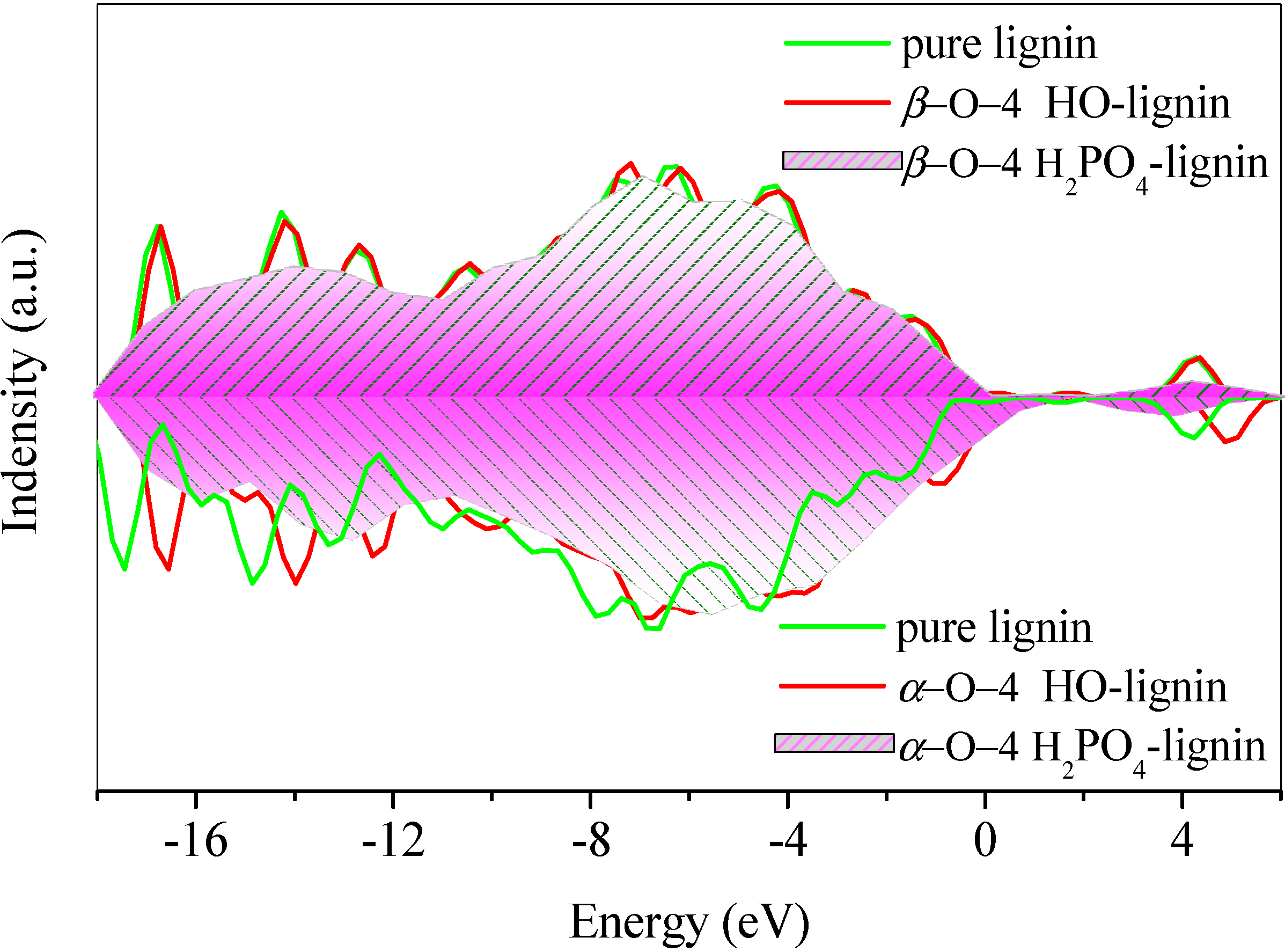

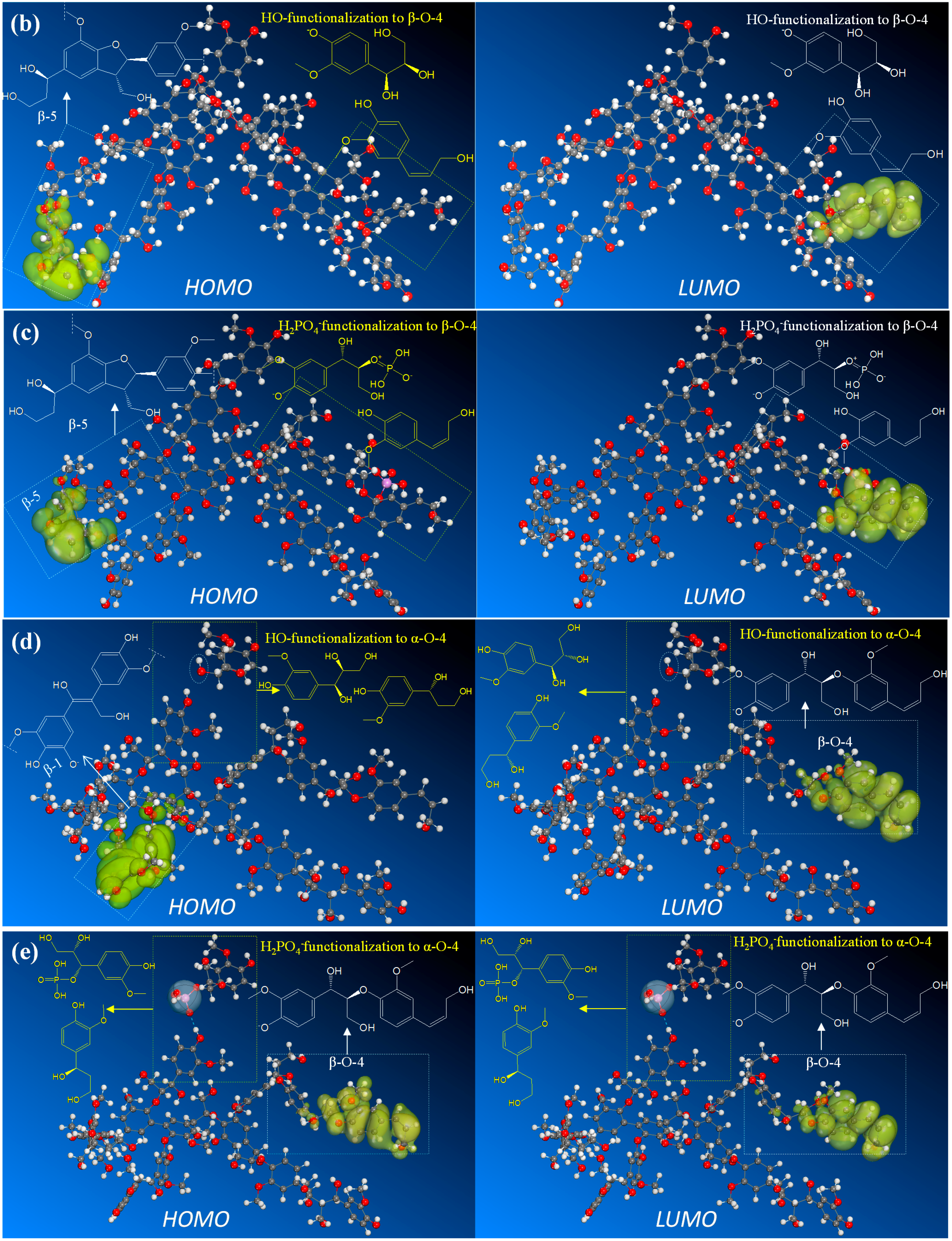
3. Computational Details
4. Conclusions
Acknowledgments
Author Contributions
Conflicts of Interest
References
- Lebo, S.E., Jr.; Gargulak, J.D.; McNally, T.J. Lignin. In Kirk-Othmer encyclopedia of chemical technology; Wiley-Interscience: New York, NY, USA, 2001; Volume 15, pp. 1–32. [Google Scholar] [CrossRef]
- Martone, P.T.; Estevez, J.M.; Lu, F.; Ruel, K.; Denny, M.W.; Somerville, C.; Ralph, J. Discovery of lignin in seaweed reveals convergent evolution of cell-wall architecture. Curr. Biol. 2009, 19, 169–175. [Google Scholar] [CrossRef] [PubMed]
- Pauly, M.; Keegstra, K. Cell-wall carbohydrates and their modification as a resource for biofuels. Plant J. 2008, 54, 559–568. [Google Scholar] [CrossRef] [PubMed]
- Doherty, W.O.; Mousavioun, P.; Fellows, C.M. Value-adding to cellulosic ethanol: Lignin polymers. Ind. Crops Prod. 2011, 33, 259–276. [Google Scholar] [CrossRef] [Green Version]
- Cybulska, I.; Brudecki, G.; Rosentrater, K.; Julson, J.L.; Lei, H. Comparative study of organosolv lignin extracted from prairie cordgrass, switchgrass and corn stover. Bioresour. Technol. 2012, 118, 30–36. [Google Scholar] [CrossRef] [PubMed]
- Lora, J.H.; Glasser, W.G. Recent industrial applications of lignin: A sustainable alternative to nonrenewable materials. J. Polym. Environ. 2002, 10, 39–48. [Google Scholar] [CrossRef]
- Cazacu, G.; Pascu, M.C.; Profire, L.; Kowarski, A.; Mihaes, M.; Vasile, C. Lignin role in a complex polyolefin blend. Ind. Crops Prod. 2004, 20, 261–273. [Google Scholar] [CrossRef]
- Nadif, A.; Hunkeler, D.; Käuper, P. Sulfur-free lignins from alkaline pulping tested in mortar for use as mortar additives. Bioresour. Technol. 2002, 84, 49–55. [Google Scholar] [CrossRef] [PubMed]
- Ugartondo, V.; Mitjans, M.; Vinardell, M.P. Comparative antioxidant and cytotoxic effects of lignins from different sources. Bioresour. Technol. 2008, 99, 6683–6687. [Google Scholar] [CrossRef] [PubMed]
- Reti, C.; Casetta, M.; Duquesne, S.; Bourbigot, S.; Delobel, R. Flammability properties of intumescent PLA including starch and lignin. Polym. Adv. Technol. 2008, 19, 628–635. [Google Scholar] [CrossRef]
- Zhang, Y.-H.P.; Cui, J.; Lynd, L.R.; Kuang, L.R. A transition from cellulose swelling to cellulose dissolution by o-phosphoric acid: Evidence from enzymatic hydrolysis and supramolecular structure. Biomacromolecules 2006, 7, 644–648. [Google Scholar] [CrossRef] [PubMed]
- Zhang, Y.H.P.; Ding, S.Y.; Mielenz, J.R.; Cui, J.B.; Elander, R.T.; Laser, M.; Himmel, M.E.; McMillan, J.R.; Lynd, L.R. Fractionating recalcitrant lignocellulose at modest reaction conditions. Biotechnol. Bioeng. 2007, 97, 214–223. [Google Scholar] [CrossRef] [PubMed]
- Moxley, G.; Zhu, Z.; Zhang, Y.-H.P. Efficient sugar release by the cellulose solvent-based lignocellulose fractionation technology and enzymatic cellulose hydrolysis. J. Agric. Food Chem. 2008, 56, 7885–7890. [Google Scholar] [CrossRef] [PubMed]
- Kim, J.; Mazza, G. Optimization of phosphoric acid catalyzed fractionation and enzymatic digestibility of flax shives. Ind. Crops Prod. 2008, 28, 346–355. [Google Scholar] [CrossRef]
- Ramos, L.A.; Assaf, J.M.; El Seoud, O.A.; Frollini, E. Influence of the supramolecular structure and physicochemical properties of cellulose on its dissolution in a lithium chloride/N, N-dimethylacetamide solvent system. Biomacromolecules 2005, 6, 2638–2647. [Google Scholar] [CrossRef] [PubMed]
- Dorrestijn, E.; Laarhoven, L.J.; Arends, I.W.; Mulder, P. The occurrence and reactivity of phenoxyl linkages in lignin and low rank coal. J. Anal. Appl. Pyrolysis 2000, 54, 153–192. [Google Scholar] [CrossRef]
- Beste, A. ReaxFF study of the oxidation of lignin model compounds for the most common linkages in softwood in view of carbon fiber production. J. Phys. Chem. A 2014, 118, 803–814. [Google Scholar] [CrossRef] [PubMed]
- Kang, P.; Zheng, Z.; Qin, W.; Dong, C.; Yang, Y. Efficient fractionation of Chinese white poplar biomass with enhanced enzymatic digestibility and modified acetone-soluble lignin. BioResources 2011, 6, 4705–4720. [Google Scholar]
- Huajing, W.; Wang, Z.Y.; Yao, C.F.; Qingxiang, G. Theoretical study on the pyrolysis process of lignin dimer model compounds. Acta Chim. Sin. 2009, 67, 893–900. [Google Scholar]
- Younker, J.M.; Beste, A.; Buchanan, A.C., III. Computational study of bond dissociation enthalpies for lignin model compounds: β-5 arylcoumaran. Chem. Phys. Lett. 2012, 545, 100–106. [Google Scholar] [CrossRef]
- Kim, S.; Chmely, S.C.; Nimlos, M.R.; Bomble, Y.J.; Foust, T.D.; Paton, R.S.; Beckham, G.T. Computational study of bond dissociation enthalpies for a large range of native and modified lignins. J. Phys. Chem. Lett. 2011, 2, 2846–2852. [Google Scholar] [CrossRef]
- Sturgeon, M.; Kim, S.; Lawrence, K.; Paton, R.S.; Chmely, S.C.; Nimlos, M.R.; Foust, T.D.; Beckham, G.T. A mechanistic investigation of acid-catalyzed cleavage of aryl-ether linkages: Implications for lignin depolymerization in acidic environments. ACS Sustain. Chem. Eng. 2014, 2, 472–485. [Google Scholar] [CrossRef]
- Nada, A.M.; Kassem, N.F.; Mohamed, S.H. Characterization and properties of ion exchangers produced from lignin precipitated after peroxyacid pulping. BioResources 2008, 3, 538–548. [Google Scholar]
- Janesko, B.G. Acid-catalyzed hydrolysis of lignin β-O-4 linkages in ionic liquid solvents: A computational mechanistic study. Phys. Chem. Chem. Phys. 2014, 16, 5423–5433. [Google Scholar] [CrossRef] [PubMed]
- Henry, N.W. Polymer Nanocomposite Analysis and Optimization for Renewable Energy and Materials. Ph.D. Thesis, The University of Tennessee, Knoxville, TN, USA, December 2011. [Google Scholar]
- Abdel-kader, A. Preparation of lignin from waste black liquors as ion exchangers. Der Chem. Sin. 2012, 3, 689–697. [Google Scholar]
- Plimpton, S. Fast parallel algorithms for short-range molecular dynamics. J. Comput. Phys. 1995, 117, 1–19. [Google Scholar] [CrossRef]
- Chenoweth, K.; van Duin, A.C.T.; Goddard, W.A., III. ReaxFF reactive force field for molecular dynamics simulations of hydrocarbon oxidation. J. Phys. Chem. A 2008, 112, 1040–1053. [Google Scholar] [CrossRef] [PubMed]
- Durbeej, B.; Eriksson, L.A. Spin distribution in dehydrogenated coniferyl alcohol and associated dilignol radicals. Holzforschung 2003, 57, 59–61. [Google Scholar]
- Durbeej, B.; Eriksson, L.A. A density functional theory study of coniferyl alcohol intermonomeric cross linkages in lignin-Three-dimensional structures, stabilities and the thermodynamic control hypothesis. Holzforschung 2003, 57, 150–164. [Google Scholar]
- Beste, A.; Buchanan, A.C., 3rd; Britt, P.F.; Hathorn, B.C.; Harrison, R.J. Kinetic analysis of the pyrolysis of phenethyl phenyl ether: Computational prediction of α/β-selectivities. J. Phys. Chem. A 2007, 111, 12118–12126. [Google Scholar] [CrossRef]
- Beste, A.; Buchanan, A.C., 3rd; Harrison, R.J. Computational prediction of α/β selectivities in the pyrolysis of oxygen-substituted phenethyl phenyl ethers. J. Phys. Chem. A 2008, 112, 4982–4988. [Google Scholar] [CrossRef]
- Beste, A.; Buchanan, A.C., 3rd. Computational study of bond dissociation enthalpies for lignin model compounds. Substituent effects in phenethyl phenyl ethers. J. Org. Chem. 2009, 74, 2837–2841. [Google Scholar] [CrossRef] [PubMed]
- Beste, A.; Buchanan, A.C., 3rd. Substituent effects on the reaction rates of hydrogen abstraction in the pyrolysis of phenethyl phenyl ethers. Energy Fuels 2010, 24, 2857–2867. [Google Scholar] [CrossRef]
- Durbeej, B.; Eriksson, L.A. Formation of β-O-4 lignin models-a theoretical study. Holzforschung 2003, 57, 466–478. [Google Scholar]
- Perdew, J.P.; Burke, K.; Wang, Y. Generalized gradient approximation for the exchange-correlation hole of a many-electron system. Phys. Rev. B 1996, 54, 16533. [Google Scholar] [CrossRef]
- Perdew, J.P.; Burke, K.; Ernzerhof, M. Generalized Gradient Approximation Made Simple. Phys. Rev. Lett. 1996, 77, 3865–3868. [Google Scholar] [CrossRef] [PubMed]
- Delley, B. An all-electron numerical method for solving the local density functional for polyatomic molecules. J. Chem. Phys. 1990, 92, 508–517. [Google Scholar] [CrossRef]
- Delley, B. From molecules to solids with the DMol3 approach. J. Chem. Phys. 2000, 113, 7756–7764. [Google Scholar] [CrossRef]
- Delley, B. Fast calculation of electrostatics in crystals and large molecules. J. Phys. Chem. 1996, 100, 6107–6110. [Google Scholar] [CrossRef]
- Wang, P.; Anderko, A. Computation of dielectric constants of solvent mixtures and electrolyte solutions. Fluid Phase Equilibria 2001, 186, 103–122. [Google Scholar] [CrossRef]
- Munson, R.A. Dielectric constant of phosphoric acid. J. Chem. Phys. 1964, 40, 2044–2046. [Google Scholar] [CrossRef]
- Kudin, K.N.; Ozbas, B.; Schniepp, H.C.; Prud’Homme, R.K.; Aksay, I.A.; Car, R. Raman spectra of graphite oxide and functionalized graphene sheets. Nano Lett. 2008, 8, 36–41. [Google Scholar] [CrossRef] [PubMed]
- Govind, N.; Petersen, M.; Fitzgerald, G.; King-Smith, D.; Andzelm, J. A generalized synchronous transit method for transition state location. Comput. Mater. Sci. 2003, 28, 250–258. [Google Scholar] [CrossRef]
- Sample Availability: Not available.
© 2014 by the authors. Licensee MDPI, Basel, Switzerland. This article is an open access article distributed under the terms and conditions of the Creative Commons Attribution license ( http://creativecommons.org/licenses/by/4.0/).
Share and Cite
Qin, W.; Wu, L.; Zheng, Z.; Dong, C.; Yang, Y. Lignin Hydrolysis and Phosphorylation Mechanism during Phosphoric Acid–Acetone Pretreatment: A DFT Study. Molecules 2014, 19, 21335-21349. https://doi.org/10.3390/molecules191221335
Qin W, Wu L, Zheng Z, Dong C, Yang Y. Lignin Hydrolysis and Phosphorylation Mechanism during Phosphoric Acid–Acetone Pretreatment: A DFT Study. Molecules. 2014; 19(12):21335-21349. https://doi.org/10.3390/molecules191221335
Chicago/Turabian StyleQin, Wu, Lingnan Wu, Zongming Zheng, Changqing Dong, and Yongping Yang. 2014. "Lignin Hydrolysis and Phosphorylation Mechanism during Phosphoric Acid–Acetone Pretreatment: A DFT Study" Molecules 19, no. 12: 21335-21349. https://doi.org/10.3390/molecules191221335



